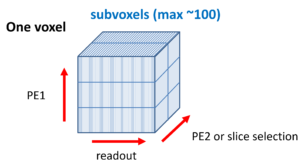This page introduce you how to set the subvoxels.
In principle, BlochSolver sets one isochromat in one voxel. Other MRI simulators may set several or many isochromats in one voxel. In contrast, BlochSolver divides one voxel into a number of subvoxels and sets one isochromat in one subvoxel.

Case 1. Inhomogeneous magnetic field within a voxel acquired with a gradient echo sequence : cylindrical object with different susceptibility


subvoxel : 1×1×2: (in-plane: 1×1) subvoxel : 2×2×2: (in-plane: 2×2)


absolute image (1×1) absolute image (2×2)
The static magnetic field is applied along the horizontal direction of the MR images.
Case 2. RF spoiled gradient echo for TR << T1, T2
2D RF spoiled gradient echo sequence, TR = 12 ms, TE = 6 ms, FA = 60°


subvoxel = 1×1×4 (11.223 s) subvoxel = 2×1×4 (21.944 s)


subvoxel = 4×1×4 (43.421 s) subvoxel = 8×1×4 (88.215 s)
The numbers in red show the calculation time using the RTX 2080Ti.
Case 3. Multiple spin echo : 16 echoes using 2π hamming windowed sinc pulse
A number of subvoxels are required in the slice direction (perpendicular to the slice plane) to describe phase accumulation in the voxel.
Image intensity vs echo time:

The number of subvoxels = 1×1×4 (sufficient for only 4 echoes).

The number of subvoxels = 1×1×8 (sufficient for only 8 echoes).

The number of subvoxels = 1×1×16 (sufficient for 16 echoes).

The number of subvoxels = 1×1×32 (too much).
